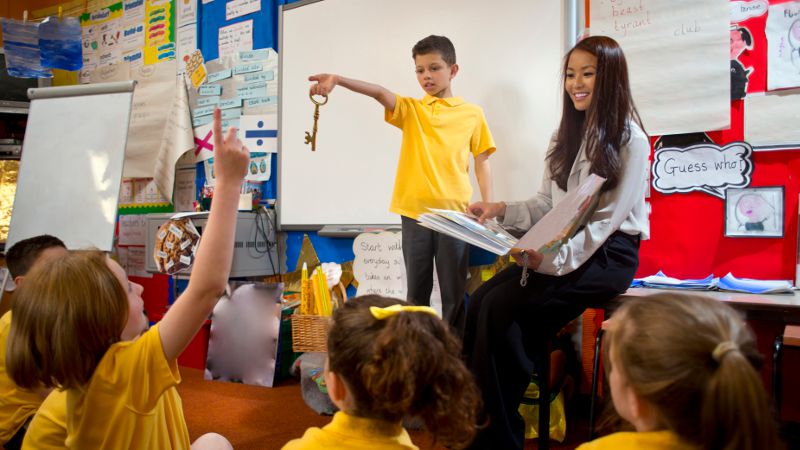
Questioning Techniques for Teachers and Teacher Aides
Questioning techniques – a set of methods used by teachers when asking questions, such as wait time and bounce.

Experienced teachers recognise the power of questions. When skilfully delivered, questions boost student engagement, improve understanding and promote critical thinking.i However, when done poorly, students shut down and quickly become deflated, bored and disengaged. A poorly chosen teacher response for an incorrect student answer can also have devastating consequences. For these reasons, a teacher’s questioning techniques can make or break a lesson. While some teaching and learning strategies are easy to learn – questioning is not one of them. There is so much more to this strategy than first meets the eye. However, with practise, reflection, and by using a few hints and tips, anyone can master this quintessential teaching strategy.
There is no doubt that teachers ask a lot of questions and we can therefore safely deduce that a teacher’s questioning skills have a sizeable impact on learning.
Teachers ask hundreds of questions almost every day; in fact, questions are responsible for a significant portion of class time. Studies have shown that teachers ask up to 120 questions per hour or 400 questions per day.ii This equates to a staggering 70,000 questions per year. Imagine the difference between 70,000 poorly phrased questions and 70,000 skilfully phrased questions! To put it another way, teachers spend around 45 minutes per day (or 4 hours per week) asking questions and listening to replies (based on 40 seconds per interaction). That’s approximately 20% of class time – more than what most teachers allocate to reading and writing combined.
There is no doubt that teachers ask a lot of questions and we can therefore safely deduce that a teacher’s questioning skills have a sizeable impact on learning. That being the case, learning to ask questions the right way is a ‘no brainer’. However, before we go any further, we need to briefly examine why teachers ask so many questions. Some of the reasons for asking questions include:
- to check for understanding
- to have students recall something
- to encourage students to articulate their ideas and thoughts
- to encourage a more in-depth understanding
- to help students link information, draw conclusions and see patterns
- to help students commit information to long-term memory
- to check progress, skills and abilities in order to make teaching and learning adjustments (formative assessment)
- to assess a student for grading purposes (summative assessment)
- to manage behavioural issues
- for logistical and practical reasons
- to monitor students’ health and wellbeing
- to elicit personal information and build rapport
- to communicate with parents, caregivers, colleagues and managers.
When skilfully delivered, questions boost student engagement, improve understanding and promote critical thinking.
There are various models that classify question types into neat categories. A favourite amongst teachers is the model below which has 5 simple categories.
| Closed | Questions tend to start with the words ‘Did’, ‘Do’, ‘Can’ and ‘Have’. Responses are limited to yes or no. Example: Did the panda cross the road? |
| Open | Questions tend to start with the words ‘What’, ‘How’ and ‘Why’ and can be recall or analytical. Responses can be detailed. Example: What was the story about? |
| Direct | Used to elicit specific information. Responses are brief factual statements. Example: Which panda crossed the road? |
| Probing | Following a response, the teachers asks for more information. Example: Correct, the panda is black and white. Why is that? |
| Hypothetical | Encourages imagination, critical thinking, critical literacy and problem solving. Example: What would you do if you saw a panda on your way home? |
An alternative model that can be used to guide best practice questioning techniques is Bloom’s taxonomy (which is the next teaching strategy in this book).
It is generally considered good practice to consciously use different types of questions throughout any given lesson. New teachers tend to ask too many direct and closed questions which require no more than simple recall. While this may be appropriate in some instances, most of the time teachers want to challenge the cognitive abilities of their students. This requires a different type of question (such as probing or hypothetical questions). Below is a brief explanation of the 5 most important questioning techniques that every teacher needs to master:
Plan Your Sequence
If you intend to hold a question session, it pays to plan your sequence of questions beforehand. With experience and practise you may not need to plan, however jotting down key points as a reminder can never hurt. Question sequences can be planned in a number of ways, such as from facts to ideas, from simple to complex, from closed to open, or from basic to difficult. Sometimes simple questions are all that are required (such as for revision and consolidation purposes). It’s also important to consider the types of answers that you might receive and your subsequent reply when planning your question sequence.
Phrase Each Question Correctly
Questions should have a single focus. It is considered bad form to pose 2 questions in 1 sentence as it can be confusing. Questions should be as short as possible and to the point – concise and precise. Consider how you phrase your questions. For example, leading questions should be avoided, such as ‘why are cities better to live in than country towns?’. This poorly phrased question assumes that cities are better than towns as if it was an established fact. The correct way to phrase this question is: ‘Is it better to live in cities or country towns?’.
However, the problem with the question now is that it a direct question and the response most likely will be limited to either ‘cities’ or ‘towns’. The teacher might follow up with a second question such as ‘what are you comparing it to?’ or for more advanced students ‘what criteria did you use to make your decision?’ (and then ‘could there be other criteria?’). In this example, the sequence began with a simple question allowing less able students to participate, and then moved to more complex questions to challenge students with higher cognitive abilities. Note that the teacher refrained from asking multiple questions at the same time and ensured that each question was only as long as it needed to be.
It's Not Just What You Say
Other factors can also impact the effectiveness of your questions, such as your:
- body language – use open hand gestures to encourage students to give you more information and nod or use facial expressions to show that an answer is correct or a good idea. Don’t use negative gestures such as folding your arms or putting your hands on your hips.
- proximity – where you choose to position yourself says a lot about your teaching style. Do you sit in a student desk or at the teacher’s desk? Consider standing at different points around the room to surprise your students. Inexperienced teachers tend to work predominantly from the front of the room – experienced teachers tend to mix it up.
Hint: try this – wait for your students to find their seats, then sit next to one of them and ‘work’ your lesson from there.
- tone and volume – experienced teachers adjust and regulate their tone, pace and volume. It’s important to speak no louder than required, to speak clearly and to use a slower pace for ESL (English as a Second Language) students. Think of your tone, pace and volume as each being on a scale out of 10. Experienced teachers adjust each depending on what they are trying to achieve. For example, what do you think 3/6/2 is for and what about 5/7/7?
Hint: try this – speak to your students using an uncomfortably low volume (even a loud whisper). This forces students to sit perfectly still and to pay really close attention. It can also add extra excitement and drama.
Hold Your Horses
Wait time is the short period of time between asking a question and selecting someone to answer it. This technique is simple, essential, effective and easy to master with almost no practise. Once you have asked the question, simply wait 3-5 seconds before choosing someone to respond. The wait time forces all learners to think of an answer in case they are the one chosen by the teacher. It also provides all students with enough time to process the question and to think of the answer. New teachers tend to choose one of the first students who raise their hands. This is a mistake that causes less able students to lose interest.
Hint: wait time can be as long as you want it to be. However, let students know if they have 30 seconds or 30 minutes to think of a reply.
Manage Incorrect Responders with Care
Incorrect responders are students who provide an answer that is either partially or completely incorrect. Non-responders are students who don’t respond at all. How you handle these students is one of the most critical and challenging aspects of using questions. If students believe that an incorrect response means that they might be embarrassed or criticised in some way, they are unlikely to eagerly participate in any public forum. This has negative consequences for their self-esteem, motivation and their sense of safety and belonging. It can also have long-term academic consequences due to reduced participation.
The most important take-away from this technique is to protect incorrect responders and non-responders. If a student gets an answer wrong, let them know that they were close, or complement them on what they did get correct. At the very least, tactfully phrase your response with something like ‘good to see you trying’ or ‘nice try – that’s a common answer – why do so many people think that?’. There are a number of ways that teachers can protect incorrect responders to ensure that they feel safe to participate:
- Keep question time positive so students don’t shut down.
- Encourage and reward all genuine participation and attempts at answers, just as you would reward a correct answer.
- Don’t ignore responses (even if they’re incorrect or partial).
- Don’t embarrass any students in any way.
- When answers are partially in/correct, concentrate on the correct aspects.
- Build on the correct aspects of their response.
- Probe for more details (positive prompting).
- Ask other students to help them or to expand on their answer.
- Consider if the question could be made easier or broken into multiple questions.
- Edit your question if it’s too hard or poorly phrased.
- Remember the ripple effect - students see how you treat their peers and act accordingly. If you embarrass student a, student b will expect to be treated in the same way.
- Redirect and ask another student or direct other students to find an answer.
- Thank learners for their attempts and input at the end of the activity.
Other Techniques
So far, we have discussed the main questioning techniques used by high-performing teachers. Here are a few simple tips to improve your practice:
- You can use a student’s response to a question as the basis for a follow-up question directed at a different student – in other words, ‘bounce’ from one student to another.
- Make question sessions fun to encourage participation and deep thinking.
- Be creative and build in metacognitive questions such as ‘what other questions should I be asking?’.
- Encourage students to develop questions to ask each other (peer questioning).
- Before a questioning activity, don’t tell students who will be chosen to answer a question. Every student needs to think that they could be asked.
- Encourage students to ask questions and show them how to phrase questions.
- Be honest if you don’t know the answer to something. An effective reply is ‘good question, I don’t know but I will find out for you’.
- If no one knows the answer to a question, ask students to find out for the next lesson.
- Try this – first give the answer, then ask ‘what was the question?’.
- Hang Bloom’s taxonomy in the classroom as a reminder to challenge students at various levels of cognitive abilities.
- Aim for wide participation so every student has the opportunity to contribute.
- Set a goal to ask every student at least one question each day.
- Set clear expectations and rules about calling out answers, raising hands, interrupting others, respectful language and other behavioural issues.
- Teach students how to respectfully disagree (e.g. appropriate language choice and reinforcing that friends can disagree).
- Check your biases – present both sides of an argument (within reason) and refrain from dominating the discussion or preaching. The questions you select (and the ones you don’t select) indicate your biases, values, moral judgements and beliefs.
- Use questions to move students toward achieving their educational goals.
- Use rapid-fire questioning (a.k.a. ‘peppering’) – like a machine gun, ask a dozen questions really quickly to drum up excitement. This is a favourite technique for revision, consolidation, quizzes and games, or when time is short. Personality plays a big role in this strategy. Take advantage of any techniques that you are naturally good at.
- Use advanced strategies such as the zone of proximal development and cognitive load theory (explained later this book) to develop your questions.
A sign that a teacher has mastered the art of questioning is when question time naturally morphs into a class discussion or even a friendly debate. It means that all students are motivated, thinking critically and the participation rate is high. Students need to feel safe for this happen; questions need to be phrased well and be interesting and engaging.
Foot notes:
- McInerney, D.M. (2013). Educational Psychology: Constructing Learning 6th Edition. Australia: Pearson Australia.
- Research also suggests that teaches spend up to 50% of their time asking questions. See for example: Almeida, P.M. (2011). Can I ask a question? the importance of classroom questioning. Procedia - Social and Behavioral Sciences 31, 634 – 638.























